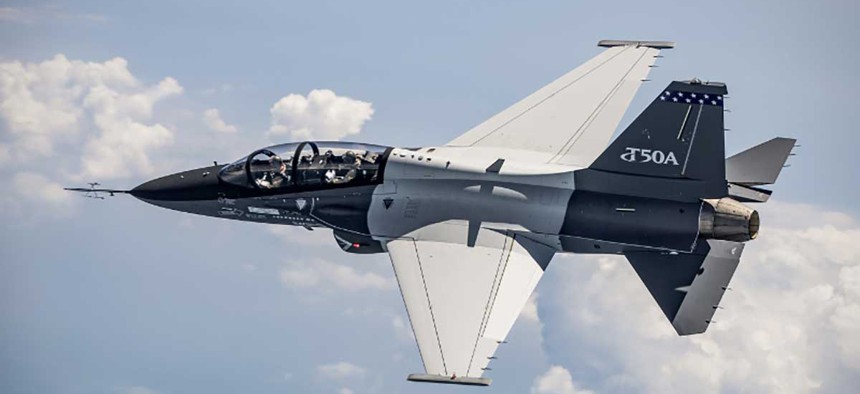Lockheed’s Pitch: Buy Our Training Jet, Save Taxpayers $1 Billion
Company officials say they can build the jets faster, and that should give them a leg up in the T-X bid evaluation.
Lockheed Martin could build new training jets for the U.S. Air Force more quickly than its competitors — enough to save $1 billion over six years, a top company executive said. And the service ought to take that into account as it evaluates bids for the $15 billion T-X project, he said.
“What we’re concerned about, frankly, is that the Air Force in their competition right now is not recognizing the value of early delivery or even on-time delivery,” said Rob Weiss, Lockheed executive vice president and general manager of Advanced Development Programs.
Lockheed is running its pursuit of the contract through Weiss’s group, the secretive division better known as the Skunk Works, birthplace of the U-2 spyplane, SR-71 Blackbird, and F-117 stealth fighter.
Here’s how the firm calculates the $1 billion in savings: The Air Force says it wants the first 16 planes ready to train pilots by 2024, but Lockheed says it could deliver the planes three years early. That would allow the Air Force to start getting rid of its T-38 Talon trainers sooner.
That means not as many Talons will need structural and other upgrades. But it also means the Air Force can start shedding a costly two-step training program that puts fighter-pilots-to-be in the 1960s-vintage Talon, then the higher-performance F-16, before they reach the fifth-generation F-22 and F-35 jets. By contrast, the modern T-X will offer the full range of undergraduate pilot training.
“Presumably, the Air Force is trying to make this a cost shootout, but they’re not looking at the additional costs that are being incurred by continuing training in an antiquated system,” Weiss said. “You’re really not shattering the cost curve if you’re having to spend potentially another billion dollars on maintaining your legacy training system while you wait on a new system.”
Read more Skunk Works Chief: How To Keep America’s Airborne Advantage
See also Sikorsky’s New Ace in the Hole: Lockheed’s Skunk Works
Lockheed officials say an internal study has validated its decision to enter the T-X bidding not with a clean-sheet design by a modified version of the T-50, a training jet jointly made by Lockheed and KAI in Korea for Seoul’s air force. The T-X version would get an all-new digital cockpit and a port for aerial refueling.
“What we did see is that [an all-new plane] was going to take a whole lot longer to develop, to test, to certify and to field, and we’ve never wavered from that position,” Weiss said.
This is also the approach taken by one rival in the T-X bidding, a team of Raytheon and Italy’s Leonardo that is offering a version of the M-346, but not Northrop Grumman and Boeing (with help from Saab), which are offering new planes.
Weiss says history shows that new-design planes often arrive late. They require certification from the military, the Federal Aviation Administration certification, or both. (While Weiss did not mention it specifically, Lockheed’s own F-35 took far longer than expected to arrive. That said, training jets are considered far less complicated.)
Executives in all camps have remained relatively tight-lipped since a list of draft parameters was announced in July. But privately, they have griped that the Air Force is not giving extra credit in the right places.
Northrop Grumman and Boeing tout their tailor-made aircraft, built to military specification using more modern manufacturing techniques. These might cost more money up front, they argue, but are a better value in the long term.
Lockheed and Raytheon-Leonardo say their planes will meet the Air Force specs faster with much lower risk. Weiss’ comments this week mark the first time a top executive has laid out specific factors a firm would like the Air Force to change when it puts out a finalized list of bidding paraments before Christmas.
What does the Air Force think? Service officials say they want to make sure the competition is open to all bidders in an attempt to get the best bang for its buck. Their draft bidding parameters stress the desire to buy a plane that is low risk to build. (Earlier this year, we told you why picking a new training jet is so difficult).
“We’re looking for balance. And the balance that we would like to see in the [bidding parameters] would provide recognition of the true value of having early or at least on-time delivery,” Weiss said.




